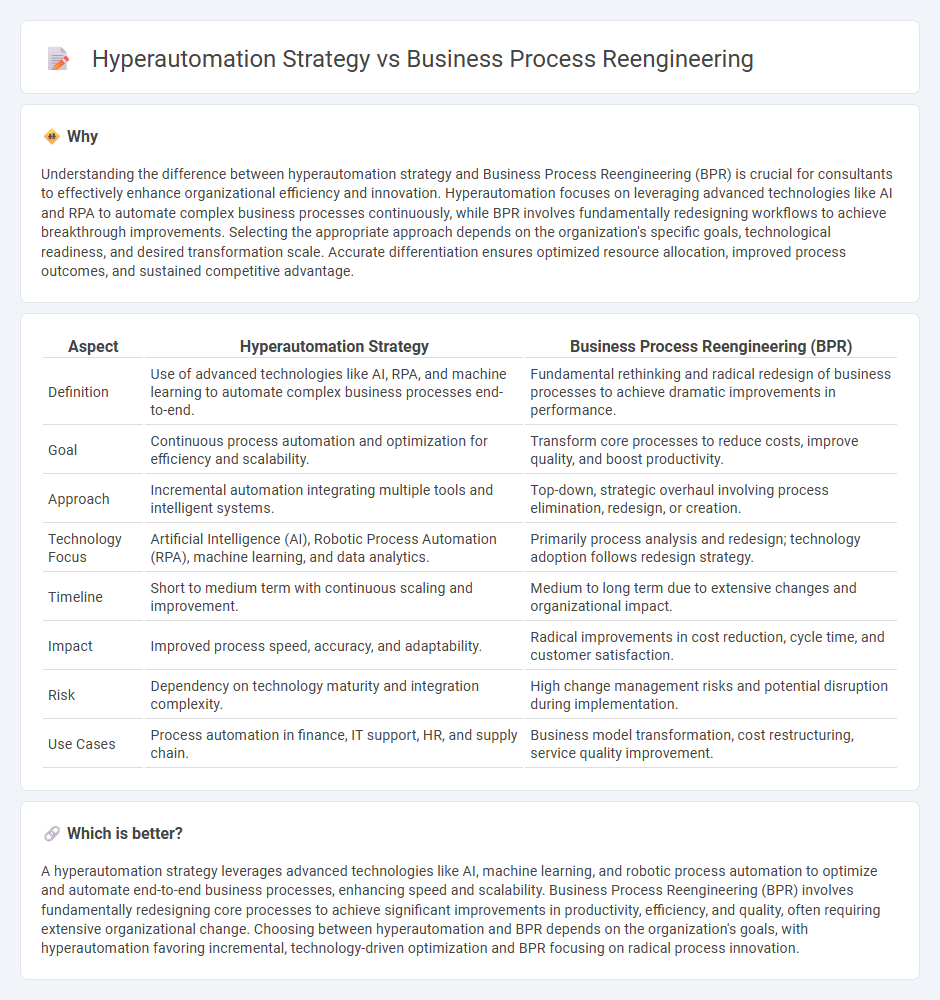
Hyperautomation strategy leverages advanced technologies such as AI, machine learning, and robotic process automation to optimize and accelerate business processes continuously. Business Process Reengineering (BPR) involves fundamental redesign of workflows and organizational structures to achieve dramatic improvements in performance, cost, and customer satisfaction. Discover how combining hyperautomation and BPR can transform operations and drive competitive advantage.
Why it is important
Understanding the difference between hyperautomation strategy and Business Process Reengineering (BPR) is crucial for consultants to effectively enhance organizational efficiency and innovation. Hyperautomation focuses on leveraging advanced technologies like AI and RPA to automate complex business processes continuously, while BPR involves fundamentally redesigning workflows to achieve breakthrough improvements. Selecting the appropriate approach depends on the organization's specific goals, technological readiness, and desired transformation scale. Accurate differentiation ensures optimized resource allocation, improved process outcomes, and sustained competitive advantage.
Comparison Table
| Aspect | Hyperautomation Strategy | Business Process Reengineering (BPR) |
|---|---|---|
| Definition | Use of advanced technologies like AI, RPA, and machine learning to automate complex business processes end-to-end. | Fundamental rethinking and radical redesign of business processes to achieve dramatic improvements in performance. |
| Goal | Continuous process automation and optimization for efficiency and scalability. | Transform core processes to reduce costs, improve quality, and boost productivity. |
| Approach | Incremental automation integrating multiple tools and intelligent systems. | Top-down, strategic overhaul involving process elimination, redesign, or creation. |
| Technology Focus | Artificial Intelligence (AI), Robotic Process Automation (RPA), machine learning, and data analytics. | Primarily process analysis and redesign; technology adoption follows redesign strategy. |
| Timeline | Short to medium term with continuous scaling and improvement. | Medium to long term due to extensive changes and organizational impact. |
| Impact | Improved process speed, accuracy, and adaptability. | Radical improvements in cost reduction, cycle time, and customer satisfaction. |
| Risk | Dependency on technology maturity and integration complexity. | High change management risks and potential disruption during implementation. |
| Use Cases | Process automation in finance, IT support, HR, and supply chain. | Business model transformation, cost restructuring, service quality improvement. |
Which is better?
A hyperautomation strategy leverages advanced technologies like AI, machine learning, and robotic process automation to optimize and automate end-to-end business processes, enhancing speed and scalability. Business Process Reengineering (BPR) involves fundamentally redesigning core processes to achieve significant improvements in productivity, efficiency, and quality, often requiring extensive organizational change. Choosing between hyperautomation and BPR depends on the organization's goals, with hyperautomation favoring incremental, technology-driven optimization and BPR focusing on radical process innovation.
Connection
Hyperautomation strategy and Business Process Reengineering (BPR) are interconnected through their focus on optimizing business workflows by integrating advanced technologies like AI, machine learning, and robotic process automation (RPA) to drastically improve efficiency and reduce costs. BPR identifies fundamental process changes that are necessary, while hyperautomation applies digital tools to automate these redesigned processes end-to-end. Combining hyperautomation with BPR enables organizations to achieve scalable, agile operations and continuous process improvement.
Key Terms
Process Redesign
Business Process Reengineering (BPR) emphasizes radical process redesign to achieve breakthrough improvements in performance metrics such as cost, quality, and speed by fundamentally rethinking workflows. Hyperautomation integrates advanced technologies like AI, RPA, and machine learning to automate and optimize processes incrementally while enabling ongoing process improvement. Explore how these strategies differ in approach and impact for transforming business processes effectively.
Workflow Automation
Business Process Reengineering (BPR) involves fundamentally redesigning workflows to achieve significant improvements in productivity, while hyperautomation integrates AI, machine learning, and RPA to automate complex processes end-to-end. Workflow automation in BPR targets streamlining specific processes for efficiency gains, whereas hyperautomation creates intelligent, adaptive workflows with continuous process optimization. Explore the latest strategies in workflow automation to understand how these approaches revolutionize operational efficiency.
Digital Transformation
Business Process Reengineering (BPR) involves fundamentally rethinking and redesigning business processes to achieve dramatic improvements in critical performance metrics such as cost, quality, and speed. Hyperautomation leverages advanced technologies like AI, machine learning, and robotic process automation to automate complex business workflows and enable continuous process optimization. Explore how integrating BPR with hyperautomation can drive comprehensive digital transformation and unlock unprecedented operational efficiency.
Source and External Links
Business Process Reengineering - Bain & Company - Business Process Reengineering (BPR) is a radical redesign of business processes aimed at achieving dramatic improvements in productivity, cycle times, quality, and satisfaction, implemented through steps including refocusing on customer needs, simplifying work, automating, reorganizing into cross-functional teams, and redefining roles for third parties or outsourcing.
A complete guide to business process reengineering (BPR) - Moxo - BPR involves a structured sequence of steps starting from identifying inefficient processes, setting clear objectives, mapping current processes, designing future workflows, assessing technology needs, implementing changes, and continuously monitoring and refining the process for operational transformation.
Business process re-engineering - Wikipedia - BPR is a comprehensive business management strategy focused on fundamentally analyzing and redesigning workflows and business processes to improve efficiency, reduce costs, and enhance customer satisfaction by rethinking both the organization's mission and its core processes to achieve significant performance gains.
 dowidth.com
dowidth.com